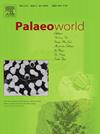Shallow-water trilobites from the Koumenzi Formation (Katian, Upper Ordovician) of Qilian, northeastern Qinghai, China: Biogeographical links with Kazakh terranes
IF 1.7
3区 地球科学
Q2 PALEONTOLOGY
引用次数: 0
Abstract
A shallow-water trilobite fauna, with low diversity (seven species of six genera), from the Koumenzi Formation (Katian) in the Qilian area, northeastern Qinghai Province, Northwest China, is recognised as the Pliomerina Association. Of these, Dulanaspis and Amphilichas are reported for the first time in the North Qilian Mountains. The shallow-water Pliomerina and relatively deep-water Birmanites-Sinocybele associations were found to occur in the Qilian and Menyuan areas, respectively, during the Katian. They exhibit a distinctive ecological differentiation with water depth from inner shelf to outer shelf environments. The Pliomerina Association of the Qilian area clearly belongs to the Pliomerina and/or Sinocybele Province of the Proto-Tethys Archipelagic Ocean. Faunal evidence indicates that the palaeogeographical position of the North Qilian Mountains area was situated closer to the Kazakh terranes during the Katian, particularly to the Chu-Ili and Chingiz-Tarbagatai terranes.
青海东北部祁连上奥陶统卡田口门子组浅水三叶虫:与哈萨克地体的生物地理联系
青海省东北部祁连地区卡田口门子组一个低多样性(6属7种)的浅水三叶虫动物群被认定为Pliomerina协会。其中Dulanaspis和Amphilichas在北祁连山首次报道。在祁连和门源地区,分别发现了浅水薄层岩和相对深水的白石岩-青石岩组合。它们从陆架内部环境到陆架外部环境表现出明显的生态分异。祁连地区的Pliomerina组合明显属于原特提斯群岛洋的Pliomerina和(或)Sinocybele省。动物区系证据表明,北祁连山地区在喀天纪时期的古地理位置更接近哈萨克地体,特别是靠近楚伊犁地体和清吉兹-塔尔巴加泰地体。
本文章由计算机程序翻译,如有差异,请以英文原文为准。
求助全文
约1分钟内获得全文
求助全文
来源期刊

Palaeoworld
PALEONTOLOGY-
CiteScore
4.00
自引率
5.90%
发文量
95
期刊介绍:
Palaeoworld is a peer-reviewed quarterly journal dedicated to the study of past life and its environment. We encourage submission of original manuscripts on all aspects of palaeontology and stratigraphy, comparisons of regional and global data in time and space, and results generated by interdisciplinary investigations in related fields. Some issues will be devoted entirely to a special theme whereas others will be composed of contributed articles. Palaeoworld is dedicated to serving a broad spectrum of geoscientists and palaeobiologists as well as serving as a resource for students in fields as diverse as palaeobiology, evolutionary biology, taxonomy and phylogeny, geobiology, historical geology, and palaeoenvironment.
Palaeoworld publishes original articles in the following areas:
•Phylogeny and taxonomic studies of all fossil groups
•Biostratigraphy, chemostratigraphy, chronostratigraphy
•Palaeoecology, palaeoenvironment and global changes throughout Earth history
•Tempo and mode of biological evolution
•Biological events in Earth history (e.g., extinctions, radiations)
•Ecosystem evolution
•Geobiology and molecular palaeobiology
•Palaeontological and stratigraphic methods
•Interdisciplinary studies focusing on fossils and strata
 求助内容:
求助内容: 应助结果提醒方式:
应助结果提醒方式:


